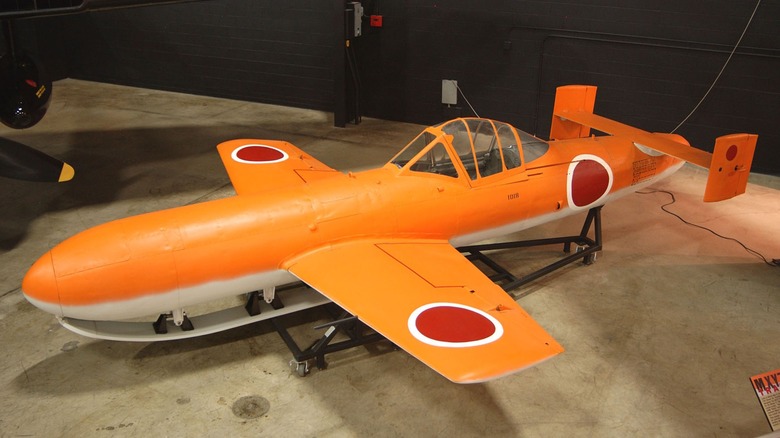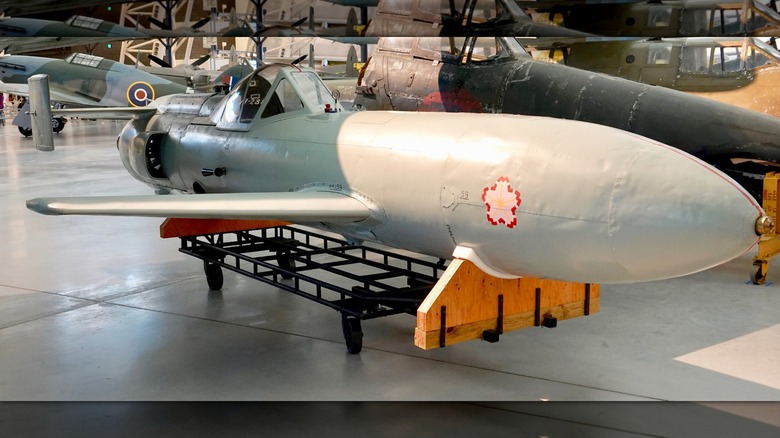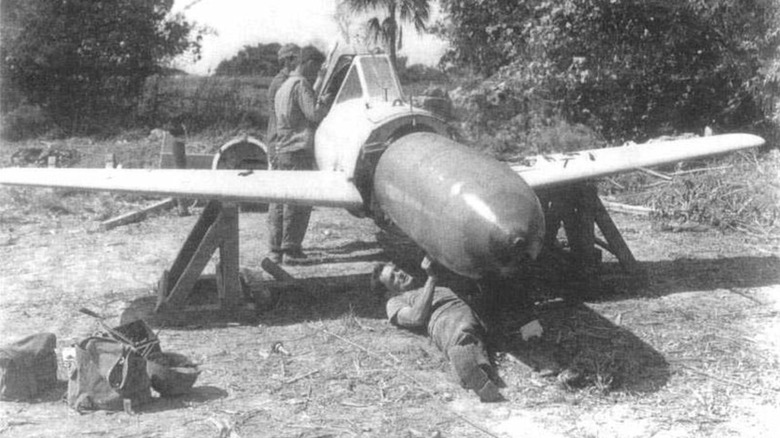The Tragic Story Of Japan's Rocket-Powered Kamikaze Plane From World War II
As World War II neared its end, Japan found itself with much of its naval forces destroyed as the Americans reconquered Japan's newly acquired islands. One way the Japanese decided to counter the threat was by using pilots known as kamikaze, which means "divine wind," to fly planes directly into ships. In a culture that embraced the idea of honorable suicide, many pilots volunteered for the honor of making the ultimate sacrifice. Japan unleashed kamikazes on the U.S. Navy at the Battle of Leyte Gulf on Oct. 25, 1944.
The attack was successful, destroying or severely damaging over two dozen ships, including two aircraft carriers that were sunk. Therefore, Japan increased the kamikaze program. Primarily, kamikaze pilots flew one of WWII's most legendary planes, the Mitsubishi A6M Zero fighters, but as Japan became more desperate, a new plane was put into production: the Kugisho MXY7 Ohka "Cherry Blossom" 22
The cherry blossom is a symbol of immense importance in Japanese culture. It exists only briefly, but it's beautiful, making it an appropriate moniker for the aircraft. The Ohka was unlike anything the Japanese put in the sky during the war. It was initially proposed in 1943 but didn't meet Japanese naval requirements. That changed when the kamikaze program was put into full production, and the Ohka became an ideal candidate, as it's essentially a flying, somewhat guidable bomb. And it was powered by three rockets, boosting its speed considerably and increasing its potential damage to American ships.
The Kugisho MXY7 Ohka Cherry Blossom
The Kugisho MXY7 Ohka "Cherry Blossom" was introduced in 1945, at the conflict's tail end. It was first used against American vessels at the Battle of Okinawa, and Japan built 852 of them. What made it so tragic was that it was purpose-built to kill its operator as violently as possible.
The Ohka was powered by three Type 4 Mark 1 Model 20 solid-fueled rocket motors, each producing 588 pounds of thrust. Once ignited, it could reach 403 mph, and its terminal dive velocity could reach 575 mph. The Ohka Model 11 was armed with a 2,600-pound Ammonal warhead.
It was carried into combat not on one of the most notable planes to fight in the Battle of the Pacific, but via the Yokusuka P1Y1 Ginga or the Mitsubishi G4M "Betty" bomber. Once released, the pilot would glide it toward a target and ignite the rockets. The combination of speed and warhead could cause devastating damage.
Several Ohka models were built, making the design faster and more lethal, though all were meant for suicidal attacks, and only the Model 11 was ever used. While a considerably powerful bomb, thanks to its warhead and jet engines, the Ohka wasn't particularly successful. After its 1945 introduction, kamikaze attacks using the Ohka sank only three U.S. ships. Ohkas damaged several others, making their success record rather limited, especially when compared to the far more successful A5M Zeroes used as kamikaze attack aircraft in earlier battles.
The limitations that doomed the Ohka
On paper, the Ohka was terribly lethal, but in practice, it was more of a cautionary tale. Because it had to be transported by a comparatively slow bomber, it was vulnerable long before it reached its target. Many Ohkas were destroyed while being carried, significantly limiting their use during the war. One of the main reasons was that the bomber had to bring the Ohka within 23 miles of its target.
The Americans called the Ohka "Baka," a Japanese word meaning "idiot" or "fool." This name wasn't applied simply to be derogatory — it was apt, given the Ohka's record. A key limitation of the aircraft, ironically, was caused by its primary characteristic — its speed. Its speed did make it almost impossible to shoot down, as hitting it wouldn't stop its descent. But its pilots had difficulty aiming it at ships, because it dove much faster than most aircraft at the time, with little ability to guide it.
So most of the Ohkas used in combat crashed in the water near their targets, killing only the pilot. As a result, the Ohka's story is doubly tragic — an aircraft designed to kill its pilot in a desperate attempt to sink enemy ships primarily succeeded in only killing its occupant, making it one of the worst weapons and aircraft in history.


